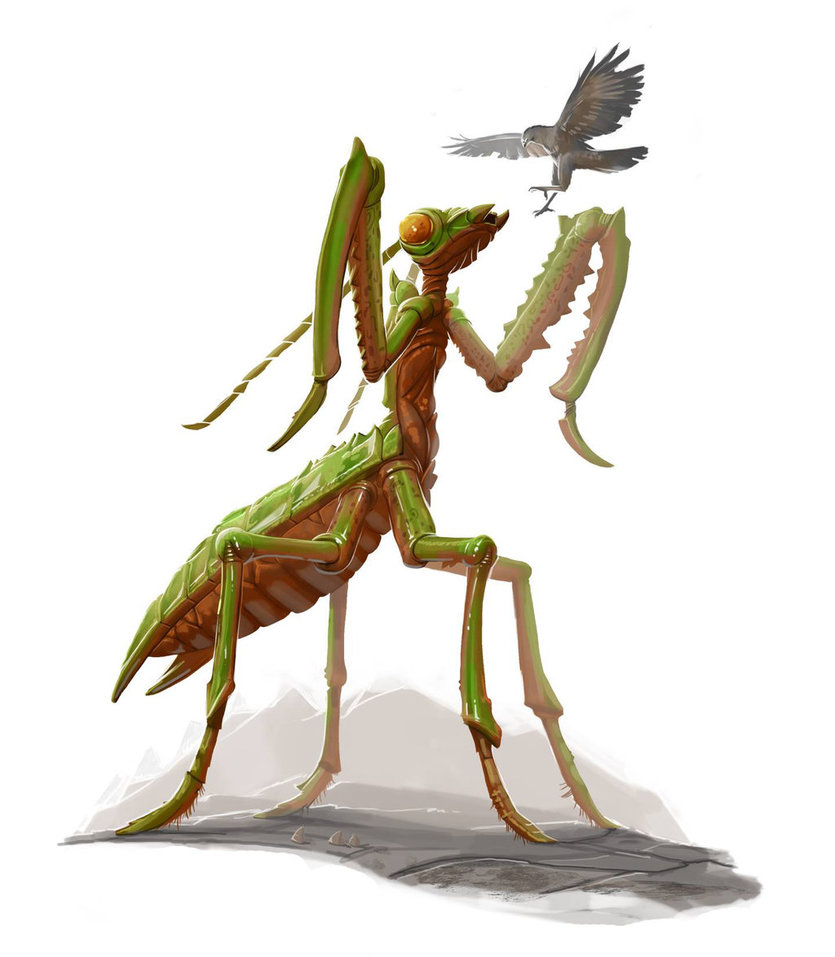Tour Mantis
The Scourge of Wormwood
Night has fallen in Les Ourais, the Wormwood of the hot and humid land of Auximâle, and the horrors have come out to play. During the day, this forest is filled with all manner of giant bugs: ants the size of dogs that the people herd like sheep, spiders the size of cows that people tame and ride like horses, and so on. There are many dangers as well, such as the dechirure ants, which cannot be domesticated and will attack a rancher's promenade ants, or the territorial enfermement millipedes that are more the size of trains than they are insects who hiss and strike at trespassers, but there is no such creature as terrifying and as prevalent in the destruction of a man's livelihood as the tour mantis.
The tour mantis is elusive, impossible to find during the day, but as the sun sets, they emerge from their lairs. They prey on ranchers who are too late getting their ants back to the farm. Such fools are never heard from again. The only things that remain are their belongings, and maybe an odd hat or two. The tour mantis is smart, and will team up with other tour mantises to take down large prey or herds. Smaller communities must be on constant watch for these horrors, for they will enter villages like children enter candy shops and take their pickings of the denizens, if given the chance.
Basic Information
Anatomy
The tour mantis ranges in tones of woody browns, to bright greens, to dark greens, all the better to disguise themselves as trees and other flora. The average tour mantis stands 12 feet tall with their forceps being able to extend the same distance as their height. Their mandibles can pierce even metal armor, which does not seem to stop them from making a meal of humans.
Genetics and Reproduction
Mantises only gather for two reasons: to hunt, and to mate. The male mantis prostrate itself to the female who then decides if she wishes to mate with the male. She then consumes his head, removing his reproductive sac from within his neck and fertilizing herself with the sac. The fertilized eggs only stay within her for 3 days, which she then deposits in a cave or dark cranny and proceeds to defend them with her life. A female tour mantis can lay up to 100 eggs, each the size of a shoe.
Growth Rate & Stages
When a tour mantis hatches from its shell, it shall find its mother which it then proceeds to consume with its other siblings, who in turn may consume each other if they remain around each other too long. These small mantises have soft shells and are relatively vulnerable, only the lucky survive to adulthood. All the while, however, a tour mantis rapidly grows and never ceases to be hungry. Most adult mantises do not die of competition or old age, but rather starve to death because they cannot supply enough calories per day to sustain their size and complex brains.
Ecology and Habitats
The tour mantis resides in Les Ourais, a grand forest in the hot and humid nation of Auximâle.
Dietary Needs and Habits
A tour mantis eats anything and everything that can move, but finds fae to be unappetizing. They prey on animal and mortal alike quite fondly, and take to stalking ranch herders from afar, hoping that they will stay out too late so that the cover of darkness will allow them to easily pick off the rancher's ants.
Additional Information
Social Structure
Solitary, except for when hunting or mating.
Domestication
Unsuccessful
Geographic Origin and Distribution
Average Intelligence
High (for an animal)
Perception and Sensory Capabilities
Tour mantises are sensitive to light and thus prefer to rest during the day, rousing at dusk to begin their hunt for a meal. They can see exceptionally well in the dark due to the their expanded light spectrum vision, which includes both infrared and ultraviolet rays.
While a tour mantis has no ears, they do poses antennae that sense vibrations of all sorts that are able to pick up more minute sounds than the human ear. This makes stalking appropriate prey quite easy as they can tell the difference between the scurrying of mice and the tromping of ants quite easily.
Image for Tour Mantis taken from: https://michaeljaecks.deviantart.com/art/Giant-praying-mantis-for-Legendary-Games-525841698 all rights to image belong to its creator.
Lifespan
Indefinite
Average Height
12 feet (3.7 meters)
Average Weight
100 pounds (45 kilograms)
Average Physique
While these giants are suprisingly light, they are also quite strong, capable of fighting things six times their own weight.
Body Tint, Colouring and Marking
Brown, Light green, Dark green
Remove these ads. Join the Worldbuilders Guild









Comments